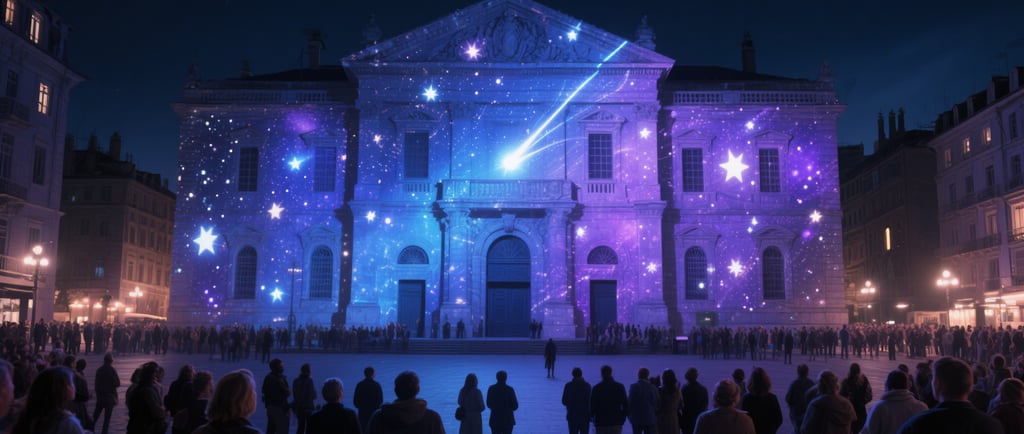Transforming Spaces: The Power of 3D Projection Mapping in Building Works
3D projection mapping projects digital images onto surfaces like buildings, integrating with their 3D geometry to create appealing visual effects, representing a blend of art and technology. It has extensive applications in building works, such as architectural visualization for stakeholders to experience building effects in advance, as urban art installations to liven up public spaces, and in commercial advertising and events to attract consumers. This technology brings many benefits, like enhancing marketing, increasing audience engagement, and flexibly transforming environments. However, it also faces challenges such as high technical specifications, the need for professional operators, and complex installation logistics. Looking ahead, 3D projection mapping will integrate with AR and VR, be applied in smart buildings, and play a greater role in architectural design, marketing, and public interaction.
ARCHITECTURAL FIELD
4/28/20255 min read


Understanding 3D Projection Mapping
3D projection mapping is an innovative technology that revolutionizes the way we perceive and interact with architectural structures. This technique involves the projection of digital images or videos onto surfaces, allowing for the transformation of ordinary objects, like buildings, into dynamic displays. At its core, 3D projection mapping merges art and technology by aligning visuals with the three-dimensional geometry of the projection surfaces. It enables artists and designers to manipulate light and shadow, creating compelling visual narratives that captivate audiences.
The process begins with identifying suitable projection surfaces, which can include any structure with unique contours and shapes. These surfaces serve as the canvas for the projected visuals. The effectiveness of 3D projection mapping heavily relies on accurate mapping of these surfaces. Using advanced video mapping techniques, creators employ specialized software to analyze and define the physical characteristics of the building, allowing for precise alignment of the projected content. This ensures that the images not only fit the surface but also interact with its architectural features, creating a heightened sense of realism and engagement.
Several types of software are pivotal in the creation of immersive 3D projection mapped experiences. Programs like Adobe After Effects, Resolume, and MadMapper enable artists to design complex animations and effects that synchronize seamlessly with the building's architecture. Through layering, modeling, and animation, these tools facilitate the crafting of magical visual experiences that can narrate a story, deliver messages, or evoke emotions. As users experience the interplay between dynamic visuals and the physical environment, they become deeply engaged, offering a fresh perspective on architectural designs.
Ultimately, 3D projection mapping is more than a technological advancement; it is a medium of artistic expression that breathes new life into static structures, transforming them into vibrant, interactive displays that resonate with viewers.
Applications of 3D Projection Mapping in Building Works
3D projection mapping has emerged as a transformative technology with wide-ranging applications in building works. This innovative technique involves projecting dynamic visuals onto surfaces, enabling architects, artists, and marketers to create immersive experiences that captivate audiences. One of the most prominent applications is in architectural visualization, where stakeholders can experience photorealistic representations of buildings even before construction begins. This not only aids in the design process but also facilitates communication between architects and clients, ensuring a clearer understanding of the final outcome.
In urban contexts, 3D projection mapping serves as a medium for artistic expression, often manifesting as urban art installations. Cities across the globe have embraced this technology to breathe life into public spaces, promoting cultural narratives and enhancing community engagement. Notable examples include festivals where buildings are transformed into vibrant canvases, displaying animations that resonate with local history or contemporary issues, thereby fostering a deeper connection between the public and their environment.
Moreover, businesses have skillfully integrated 3D projection mapping into advertising campaigns, utilizing the technology to capture consumer attention in a saturated market. By projecting advertisements onto building facades, companies create a striking visual impact that enhances brand recognition and engages potential customers. Events such as concerts and festivals also frequently employ projection mapping, orchestrating visual displays that complement performances, thereby enriching the audience's overall experience. A case study worth mentioning is the iconic projection during the New Year's Eve celebrations in major urban centers, where large-scale mappings have not only entertained attendees but also facilitated tourism and local business promotions.
The versatility of 3D projection mapping is what makes it an invaluable tool in contemporary building works. By redefining spaces, this technology fosters creativity and establishes memorable experiences, ultimately leaving an enduring impression on viewers.
Benefits and Challenges of Projection Technology Services
The integration of projection technology services in building works presents a myriad of benefits that can significantly enhance marketing and engagement strategies. One notable advantage is the enhancement of marketing opportunities. By utilizing 3D projection mapping, businesses can showcase their products and services in a visually captivating manner, drawing in potential clients and investors. This innovative approach allows for unique storytelling, enabling companies to create immersive experiences that resonate with audiences and communicate the essence of their brand more effectively.
Improved audience engagement is another key benefit of projection technology services. Traditional methods of presentation may fall flat in captivating an audience’s attention. However, projection mapping transforms ordinary spaces into dynamic environments where visuals and narratives can intertwine seamlessly. Such engagement not only fosters a deeper connection with the audience but also encourages memorable interactions, as viewers are often left with a lasting impression of the experience.
Furthermore, the technology offers the ability to transform environments with relative ease. Projection mapping can adapt various surfaces into a canvas for showcase, making it possible to utilize existing architecture creatively. This adaptability allows for quick alterations to presentations based on different themes or events, reducing the need for extensive physical modifications.
Despite these advantages, there are challenges associated with utilizing projection technology services in building works. Technical limitations can arise, such as required equipment specifications that may not be easily met. Additionally, the need for skilled operators cannot be overstated; proficient handling of the technology is essential to achieving the desired outcomes. Lastly, logistical issues during installation and setup can pose a challenge, necessitating careful planning and execution to ensure smooth operation. Thus, while the potential of projection technology is vast, it is imperative for companies to weigh both its benefits and challenges carefully.
The Future of 3D Projection Mapping in Architecture
As technology evolves, 3D projection mapping is poised to play an increasingly significant role in the field of architecture. This innovative technique has revolutionized the way architects conceptualize and present their designs, moving beyond static blueprints to dynamic visual experiences. Future advancements in this area are likely to enhance not only the aesthetic appeal of architectural projects but also their functional capabilities.
One of the most promising trends is the integration of 3D projection mapping with augmented reality (AR) and virtual reality (VR). For architects, this combination can offer immersive experiences in which stakeholders can interact with digital models in real-time. By overlaying digital designs on physical spaces, architects can effectively communicate their vision, garner feedback, and implement necessary changes more efficiently than ever before. This synergy between real and virtual elements not only enhances client presentations but could also streamline the design process, ultimately leading to more innovative and tailored outcomes.
Furthermore, as smart technology continues to permeate our societies, the possibilities for integrating 3D projection mapping into smart buildings are immense. Buildings equipped with advanced lighting systems and responsive surfaces can use dynamic projections to signal various functions—from guiding occupants through spaces to enriching their experiences with contextually relevant information. Architects will increasingly experiment with these technologies to create buildings that are not just passive structures, but active participants in their environments.
The future of 3D projection mapping in architecture also extends to marketing and public engagement. With vibrant projections on building facades, architectural firms can capture the attention of onlookers, creating memorable visual narratives that enhance a building's identity. This ability to transform how spaces are perceived could significantly alter the architectural landscape, making building works not only functional but also captivating spectacles that engage the public.
Explore
Discover immersive 3D projection technology and effects.
Innovate
Engage
© 2025. 3DD HK All rights reserved. powered by Prodesign.hk
